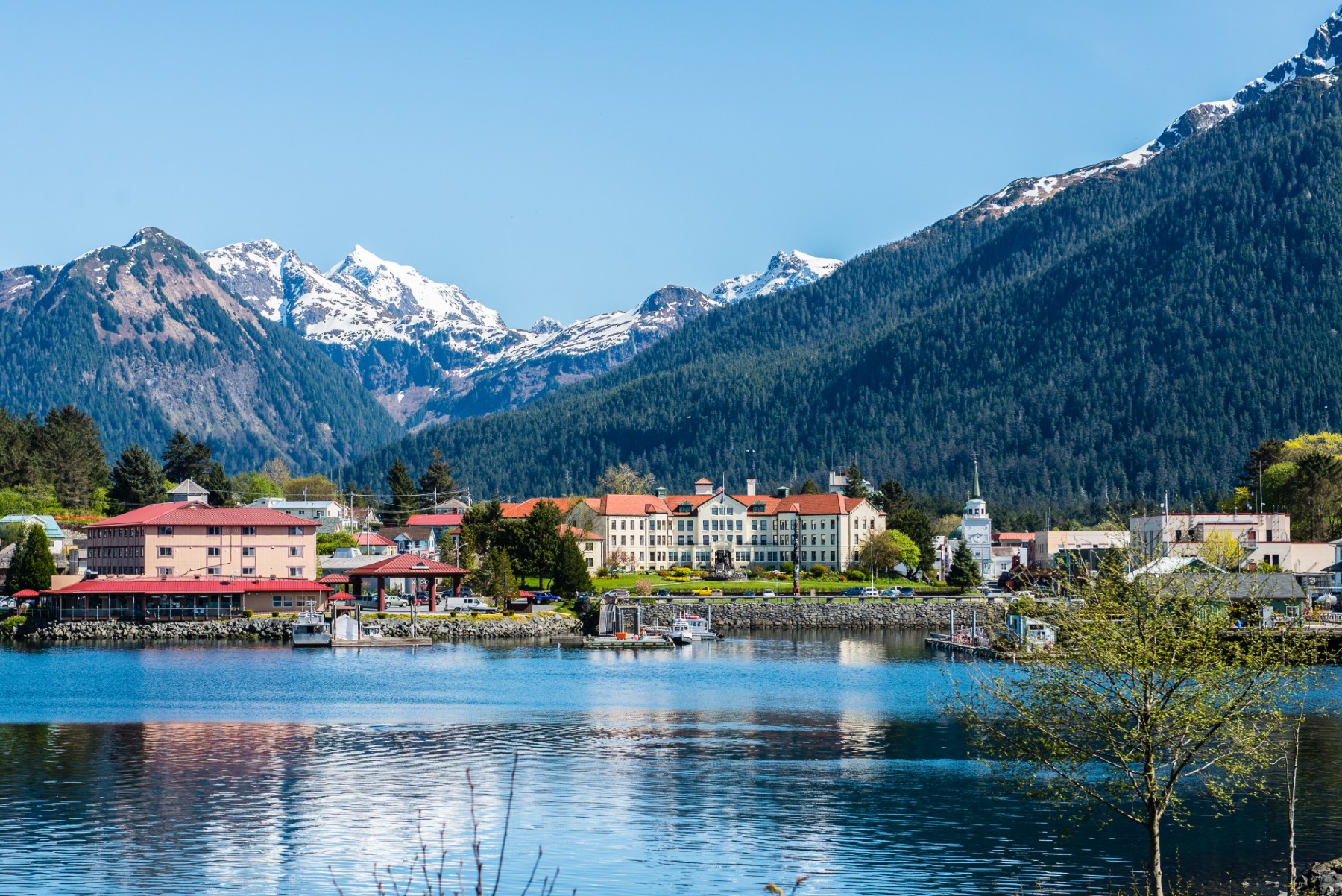In the late 1800s, on the beautiful forest land where Indian River and Sitka Sound converge, an informal community park formed. On recommendation by local officials, President Benjamin Harrison declared the land a federally designated park, and on June 21st, 1890, Alaska’s oldest federal park was born. Originally named Sitka Park, it has been known by several different names throughout its 130-year history. In 1972, the park received its current name: Sitka National Historical Park (SNHP).
In 1903, Alaska District Governor John Brady, who was living in Sitka, assembled a remarkable collection of totem poles from across Southeast Alaska . The following year, the poles were shipped to St. Louis for display outside the Alaska Pavilion at the Louisiana Purchase Exposition . The poles were then moved to the Louis and Clark Centennial Exposition in Portland, Oregon, before finally returning to Sitka in 1906, where they were placed along a seaside pathway through the federal park.
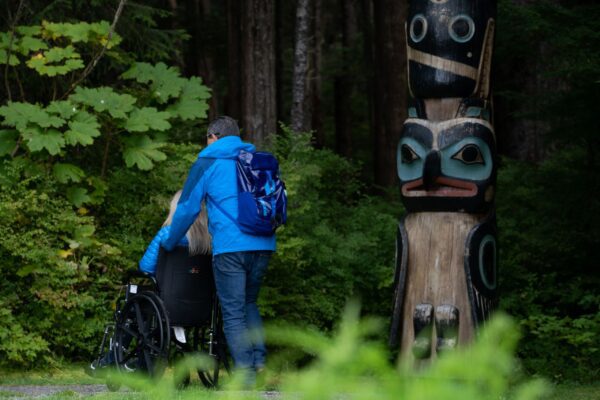
A couple getting up close and personal with one of the poles lining the trail
By the 1930s, the poles had badly deteriorated and were in serious need of repair. Through funding from the Works Progress Administration and the Civilian Conservation Corps, a crew of 10 Tlingit carvers, including lead carver George Benson, was hired to restore the poles. In the current SNHP Visitor Center, you can still see some of these original poles in a specially designed climate-controlled display room that protects these delicate artifacts.
When you visit the park today, you can admire the thriving culture of the Alaska Native people by watching Native artists working in the carving shed. One of the most well-known and longest standing artists at the park is Tlingit master carver Tommy Joseph. His working relationship with the park spans over 30 years, and he has cared many of the replica poles that now line the SNHP trails. No matter the weather, the park’s carving shed feels like an oasis of calm. Visitors can spend time with Tommy and ask questions as they watch him turn plain logs into priceless art, breathing in the smells of fresh-cut yellow cedar, wet paint, and nearby Sitka spruce trees.
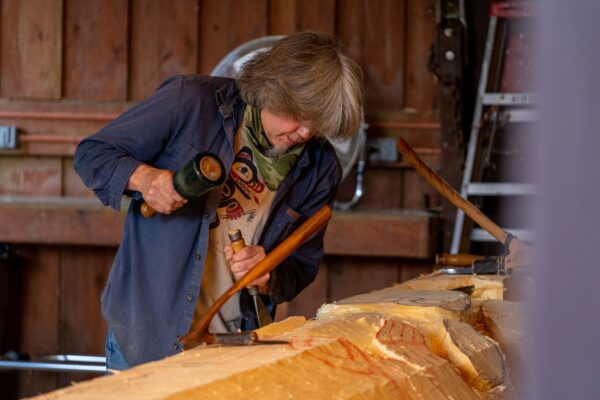
Tommy Joseph hard at work at the carving shed in Sitka National Historical Park
“I knew that I was either going to be a magician or a woodcarver,” says Tommy, gesturing to the half-carved totem pole resting in the outdoor studio. “This is my magic now though.” His tools, from an elbow adze to Western-style gouges, are all laid out in front of him.
The totem pole is a reproduction of the “Waasgo Legend Pole” for Sitka National Historical Park. The pole tells the story of a son, mother-in-law, and a lake monster. In this version of the story, the son dies, while the mother-in-law was portrayed as the villain. “But in the original version, it’s the opposite. Through research, you see how the story has evolved over 200 years,” Tommy explains.
“Making a reproduction is totally unlike doing an original. It’s like a puzzle. You have to study it, take it apart, and put it back together. There’s a lot of research involved.”
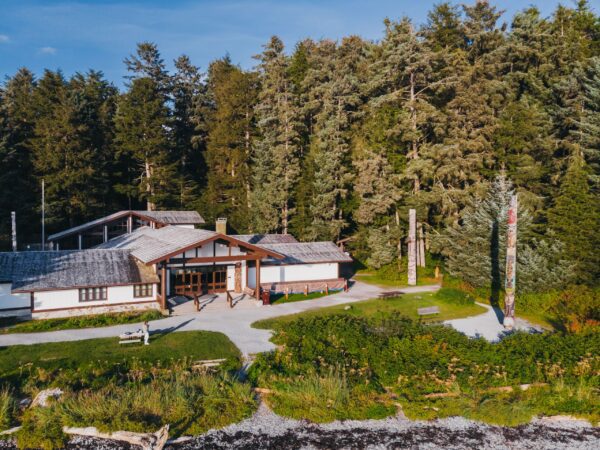
SNHP Visitor Center, Centennial Pole, and carving shed, and entrance to the totem loop
Tommy’s career began in Ketchikan when, in the third grade, he began attending carving lessons in an A-frame studio behind his elementary school. Later, he came to Sitka to work and teach at the Southeast Alaska Indian Cultural Center. The most important lesson for his students?
“Always work from a centerline to give balance to what you do.”
The carving process itself takes months. Once Tommy has finished carving a pole, transporting it requires creativity and a sense of adventure – especially if its new home is located outside of Sitka. For his last pole, Tommy relied on a seiner from Petersburg to pick him up and transport them both; he even had the chance to carve on deck. Another time, Tommy delivered an eleven-foot pole on a fourteen-foot sailboat.
When he’s not carving totem poles, Tommy works on other projects – a dug-out canoe, satire masks, and Tlingit armor among them.
“Always work from a centerline to give balance to what you do.”
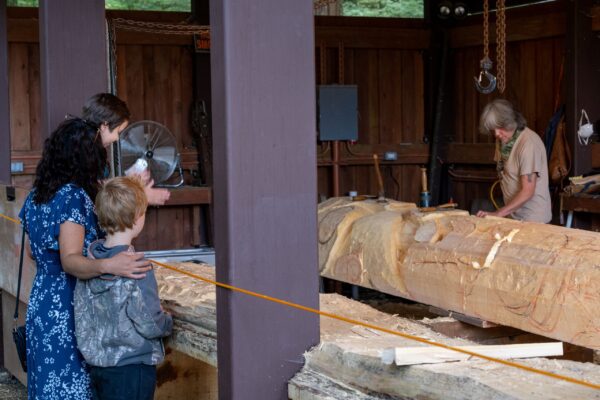
Family watching Tommy’s process
“I got into Tlingit armor because we were coming on the 200-year anniversary of the 1804 battle with the Russians. I traveled to Europe and Russia to research Tlingit armor … The more I dug in, the more I learned. I couldn’t think about anything else. I made helmet after helmet. People were giving me wood, and I was running out.”
When discussing the future, Tommy’s passion for his work is evident. “Not everyone wants or needs a totem pole, but in certain places and settings, they really do. I’m always going to be doing this, for as long as I can. The old pieces are my teachers.”
SNHP is a popular destination with visitors, and many tour companies offer guided walks through the park, telling stories of the historic land. The park is best explored with a guide- whether that’s through a tour company, with an experienced Sitkan, or on your own with the assistance of NPS app self-guided tours.
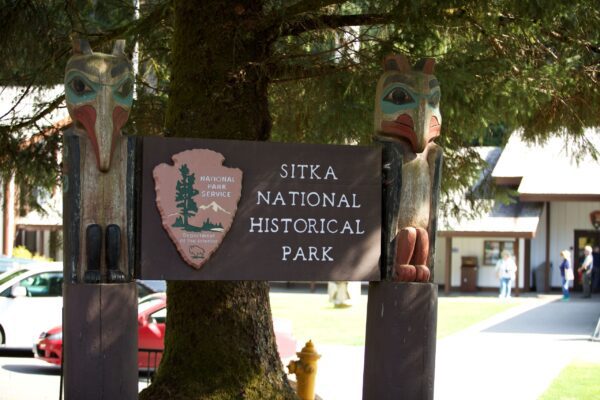
Entering the park (Copyright 2019 Brian Adams, Photo credit: Robert Wood Johnson Foundation)
Alaska Coach Tours
Alaska Coach Tours gives visitors the opportunity to view Southeast Alaska from the comfortable seat of a motorcoach. Their popular Best of Sitka Tour visits the Alaska Rehabilitaition Raptor Center, Fortress of the Bear, and SNHP- Sitka’s top three attractions.
Sitka Tours
Sitka Tours offers two tours that visit the park. Their Sitka Historic Tour, a 3.5 hour bus tour covering some of the major historical sites, or, if you’re feeling a little more active, take their Walk Sitka 2.5 hour tour, that guides you through town, past some historical sites, and ends at SNHP.
Sitka Tribal Tours
Discover the Tlingit way of life with Sitka Tribal Tours. Two tour options give you the ability to choose how long you’d like to spend touring. Their Explore Sitka Cultural Tour, a 2.5 hour bus tour, covers a history briefing during your ride, and stops at SNHP and ends with a traditional Tlingit dance performance at the Naa Kahidi Community Tribal House. Their 3.5 hour tour option covers the dance performance and SNHP, and adds a visit to the Alaska Raptor Rehabilitation Center on top of it.
Sitka Wildlife Tours
Sitka Wildlife Tours offers a wide variety of tour options, ranging from bus tours that visit all of our most popular attractions, to private, create-your-own custom tours. Online booking allows a convenient way to secure your tour and get around the island.
